Welcome to José Lourenço's webpage.
I am a Research Associate at the Department of Zoology, Peter Medawar Building for Pathogen Research
(University of Oxford) and a Principal Investigator at BioISI/FCUL (University of Lisbon) with a rich record in research, supervision and education in the
area of computational epidemiology and population biology of infectious disease. I am member of the editorial
board of Nature Scientific Reports on Infectious Diseases.
My expertise and primary research interests are in the epidemiology and
evolution of multi-strain pathogens. I am particularly motivated by the
research potential of dynamic, mathematical models that allow us to infer
biological mechanisms from computer simulations and epidemiological data.
Open-source projects
MVSE R-package
MVSE is the Mosquito-borne Viral Suitability index Estimator,
an R-package offering tools to estimate the climate-driven
transmission potential of a mosquito-borne pathogen.
See dedicated page.

MANTIS R-package
MANTIS is the Multi-locus ANTIgenic Simulator,
an R-package offering tools to simulate the
transmission dynamics of multi-strain pathogens according to strain theory.
See dedicated page.

HBV control R-tool
An R-tool that implements a dynamic model of HBV transmission recently
developed to explore the likelihood of reaching elimination goals by 2030.
This code allows to fit the model to prevalence data.
See dedicated page.

Selected recent publications

Abstract: It is unclear whether West Nile virus (WNV) circulates endemically in Portugal. Despite the country’s adequate climate for transmission, Portugal has only reported four human WNV infections so far. We performed a review of WNV-related data (1966–2020), explored mosquito (2016–2019) and land type distributions (1992–2019), and used climate data (1981–2019) to estimate WNV transmission suitability in Portugal. Serological and molecular evidence of WNV circulation from animals and vectors was largely restricted to the south. Land type and climate-driven transmission suitability distributions, but not the distribution of WNV-capable vectors, were compatible with the North-South divide present in serological and molecular evidence of WNV circulation. Our study offers a comprehensive, data-informed perspective and review on the past epidemiology, surveillance and climate-driven transmission suitability of WNV in Portugal, highlighting the south as a subregion of importance. Given the recent WNV outbreaks across Europe, our results support a timely change towards local, active surveillance.
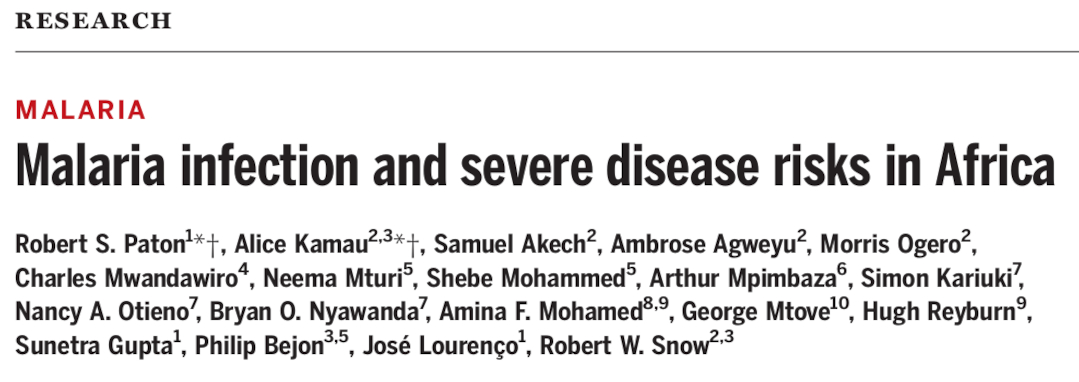
Abstract: The relationship between community prevalence of Plasmodium falciparum and the burden of severe, life- threatening disease remains poorly defined. To examine the three most common severe malaria phenotypes from catchment populations across East Africa, we assembled a dataset of 6506 hospital admissions for malaria in children aged 3 months to 9 years from 2006 to 2020. Admissions were paired with data from community parasite infection surveys. A Bayesian procedure was used to calibrate uncertainties in exposure (parasite prevalence) and outcomes (severe malaria phenotypes). Each 25% increase in prevalence conferred a doubling of severe malaria admission rates. Severe malaria remains a burden predominantly among young children (3 to 59 months) across a wide range of community prevalence typical of East Africa. This study offers a quantitative framework for linking malaria parasite prevalence and severe disease outcomes in children.
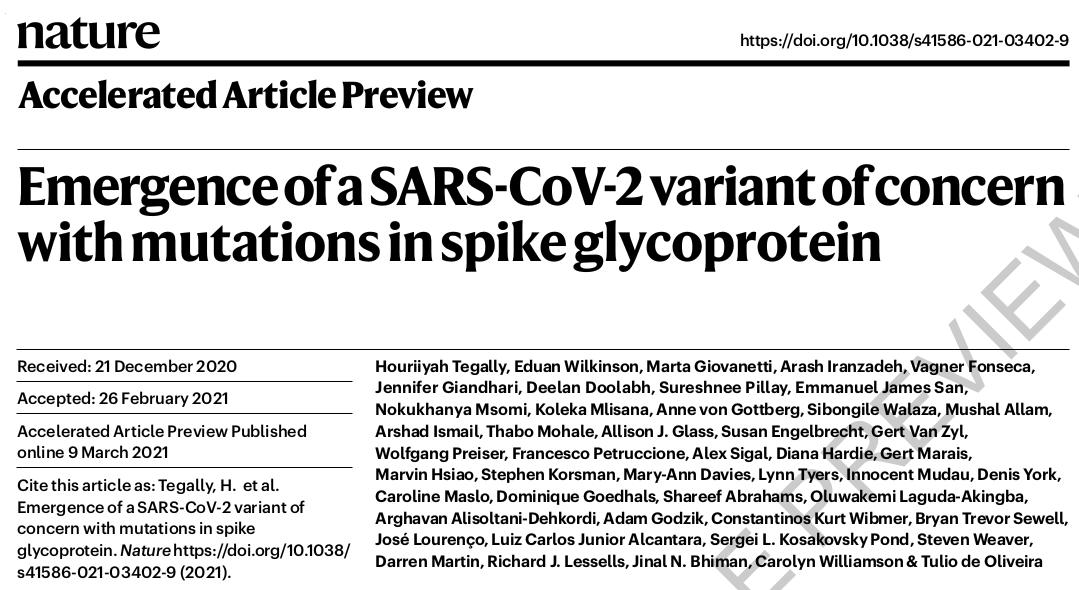
Abstract: Continued uncontrolled transmission of the severe acute respiratory syndrome-related coronavirus 2 (SARS-CoV-2) in many parts of the world is creating the conditions for significant virus evolution. Here, we describe a new SARS-CoV-2 lineage (501Y.V2) characterised by eight lineage-defining mutations in the spike protein, including three at important residues in the receptor-binding domain (K417N, E484K and N501Y) that may have functional significance. This lineage was identified in South Africa after the first epidemic wave in a severely affected metropolitan area, Nelson Mandela Bay, located on the coast of the Eastern Cape Province. This lineage spread rapidly, becoming dominant in the Eastern Cape, Western Cape and KwaZulu-Natal Provinces within weeks. Whilst the full significance of the mutations is yet to be determined, the genomic data, showing the rapid expansion and displacement of other lineages in multiple regions, suggest that this lineage is associated with a selection advantage, most plausibly as a result of increased transmissibility or immune escape.
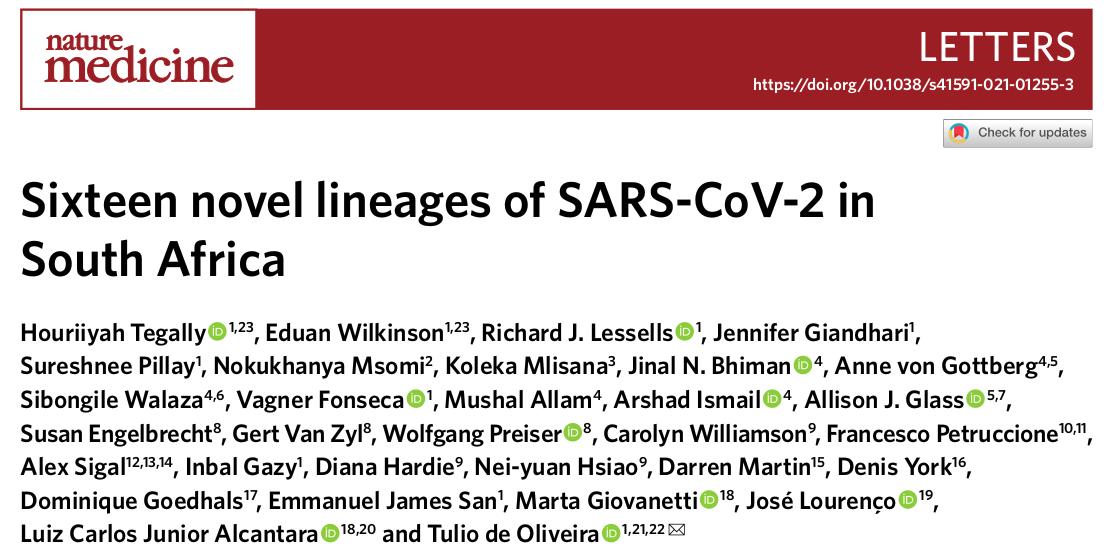
Abstract: The first severe acute respiratory syndrome coronavirus 2 (SARS-CoV-2) infection in South Africa was identified on 5 March 2020, and by 26 March the country was in full lockdown (Oxford stringency index of 90) 1 . Despite the early response, by November 2020, over 785,000 people in South Africa were infected, which accounted for approximately 50% of all known African infections 2 . In this study, we analyzed 1,365 near whole genomes and report the identification of 16 new lineages of SARS-CoV-2 isolated between 6 March and 26 August 2020. Most of these lineages have unique mutations that have not been identified elsewhere. We also show that three lineages (B.1.1.54, B.1.1.56 and C.1) spread widely in South Africa during the first wave, comprising ~42% of all infections in the country at the time. The newly identified C lineage of SARS-CoV-2, C.1, which has 16 nucleotide mutations as compared with the original Wuhan sequence, including one amino acid change on the spike protein, D614G, was the most geographically widespread lineage in South Africa by the end of August 2020. An early South African-specific lineage, B.1.106, which was identified in April 2020, became extinct after nosocomial outbreaks were controlled in KwaZulu-Natal Province. Our findings show that genomic surveillance can be implemented on a large scale in Africa to identify new lineages and inform measures to control the spread of SARS-CoV-2. Such genomic surveillance presented in this study has been shown to be crucial in the identification of the 501Y.V2 variant in South Africa in December 2020.
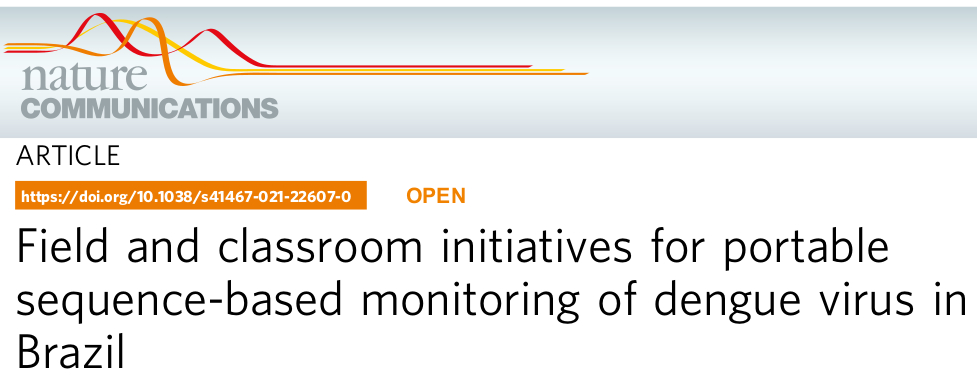
Abstract: Brazil experienced a large dengue virus (DENV) epidemic in 2019, highlighting a continuous struggle with effective control and public health preparedness. Using Oxford Nanopore sequencing, we led field and classroom initiatives for the monitoring of DENV in Brazil, generating 227 novel genome sequences of DENV1-2 from 85 municipalities (2015–2019). This equated to an over 50% increase in the number of DENV genomes from Brazil available in public databases. Using both phylogenetic and epidemiological models we retrospectively reconstructed the recent transmission history of DENV1-2. Phylogenetic analysis revealed complex patterns of transmission, with both lineage co-circulation and replacement. We identified two lineages within the DENV2 BR-4 clade, for which we estimated the effective reproduction number and pattern of seasonality. Overall, the surveillance outputs and training initiative described here serve as a proof-of-concept for the utility of real-time portable sequencing for research and local capacity building in the genomic surveillance of emerging viruses.
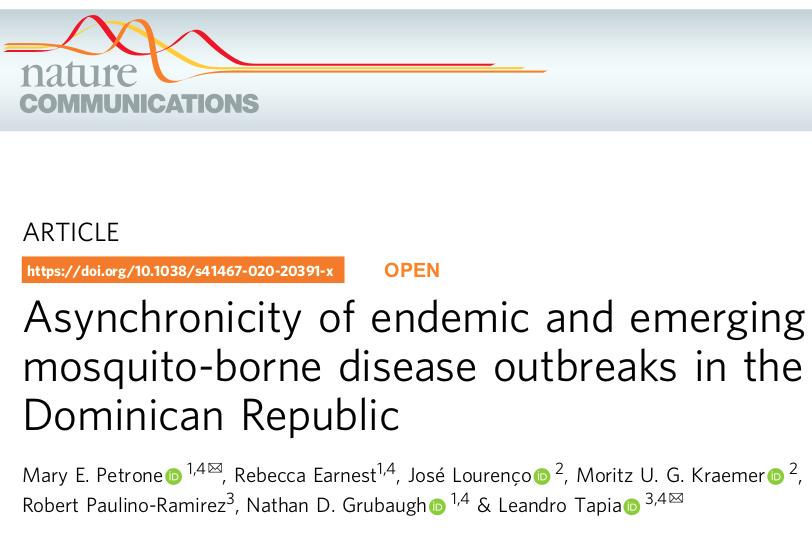
Abstract: Mosquito-borne viruses threaten the Caribbean due to the region’s tropical climate and seasonal reception of international tourists. Outbreaks of chikungunya and Zika have demonstrated the rapidity with which these viruses can spread. Concurrently, dengue fever cases have climbed over the past decade. Sustainable disease control measures are urgently needed to quell virus transmission and prevent future outbreaks. Here, to improve upon current control methods, we analyze temporal and spatial patterns of chikungunya, Zika, and dengue outbreaks reported in the Dominican Republic between 2012 and 2018. The viruses that cause these outbreaks are transmitted by Aedes mosquitoes, which are sensitive to seasonal climatological variability. We evaluate whether climate and the spatio-temporal dynamics of dengue outbreaks could explain patterns of emerging disease outbreaks. We find that emerging disease outbreaks were robust to the climatological and spatio-temporal constraints defining seasonal dengue outbreak dynamics, indicating that constant surveillance is required to prevent future health crises.

Abstract: Reverse-transcription PCR (RT-PCR) assays are used to test for infection with the SARS-CoV-2 virus. RT-PCR tests are highly specific and the probability of false positives is low, but false negatives are possible depending on swab type and time since symptom onset. Aim: To determine how the probability of obtaining a false-negative test in infected patients is affected by time since symptom onset and swab type. Methods: We used generalised additive mixed models to analyse publicly available datafrom patients who received multiple RT-PCR tests and were identified as SARS-CoV-2 positive at least once. Results: The probability of a positive test decreased with time since symptom onset, with oropharyngeal (OP) samples less likely to yield a positive result than nasopharyngeal (NP) samples. The probability of incorrectly identifying an uninfected individual due to a false-negative test was considerably reduced if negative tests were repeated 24 hours later. For a small false-positive test probability (<0.5%), the true number of infected individuals was larger than the number of positive tests. For a higher false-positive test probability, the true number of infected individuals was smaller than the number of positive tests. Conclusion: NP samples are more sensitive than OP samples. The later an infected individual is tested after symptom onset, the less likely they are to test positive. This has implications for identifying infected patients, contact tracing and discharging convalescing patients who are potentially still infectious.
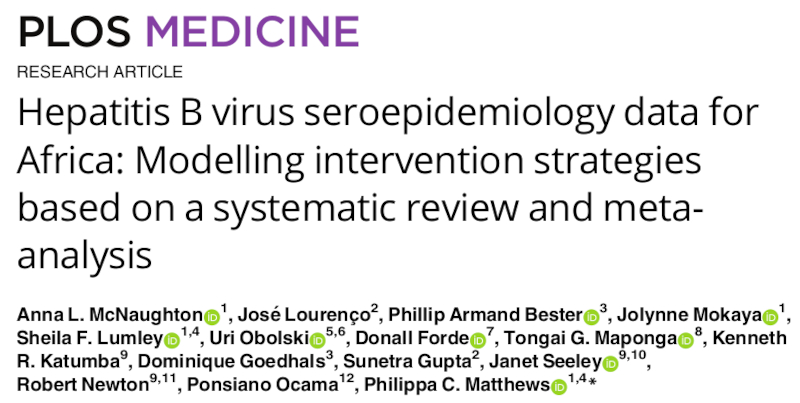
Abstract: International Sustainable Development Goals (SDGs) for elimination of hepatitis B virus (HBV) infection set ambitious targets for 2030. In African populations, infant immunisation has been fundamental to reducing incident infections in children, but overall population prevalence of chronic hepatitis B (CHB) infection remains high. In high-prevalence populations , adult catch-up vaccination has sometimes been deployed, but an alternative Test and Treat (T&T) approach could be used as an intervention to interrupt transmission. Universal T&T has not been previously evaluated as a population intervention for HBV infection , despite high-profile data supporting its success with human immunodeficiency virus (HIV). Methods and findings: We set out to investigate the relationship between prevalence of HBV infection and exposure in Africa, undertaking a systematic literature review in November 2019. We identified published seroepidemiology data representing the period 1995–2019 from PubMed and Web of Science, including studies of adults that reported prevalence of both hepatitis B surface antigen (HBsAg; prevalence of HBV infection) and antibody to hepatitis B core antigen (anti-HBc; prevalence of HBV exposure). We identified 96 studies representing 39 African countries, with a median cohort size of 370 participants and a median participant age of 34 years. Using weighted linear regression analysis, we found a strong relationship between the prevalence of infection (HBsAg) and exposure (anti-HBc) (R 2 = 0.45, p < 0.001). Region-specific differences were present, with estimated CHB prevalence in Northern Africa typically 30% to 40% lower (p = 0.007) than in Southern Africa for statistically similar exposure rates, demonstrating the need for intervention strategies to be tailored to individual settings . We applied a previously published mathematical model to investigate the effect of interventions in a high-prevalence setting. The most marked and sustained impact was porjected with a T&T strategy, with a predicted reduction of 33% prevalence by 20 years (95% CI 30%–37%) and 62% at 50 years (95% CI 57%–68%), followed by routine neonatal vaccination and prevention of mother to child transmission (PMTCT; at 100% coverage). In contrast , the impact of catch-up vaccination in adults had a negligible and transient effect on population prevalence. The study is constrained by gaps in the published data, such that we could not model the impact of antiviral therapy based on stratification by specific clinical criteria and our model framework does not include explicit age-specific or risk-group assumptions regarding force of transmission. Conclusions: The unique data set collected in this study highlights how regional epidemiology data for HBV can provide insights into patterns of transmission, and it provides an evidence base for future quantitative research into the most effective local interventions. In combination with robust neonatal immunisation programmes, ongoing PMTCT efforts, and the vaccination of high-risk groups, diagnosing and treating HBV infection is likely to be of most impact in driv- ing advances towards elimination targets at a population level.
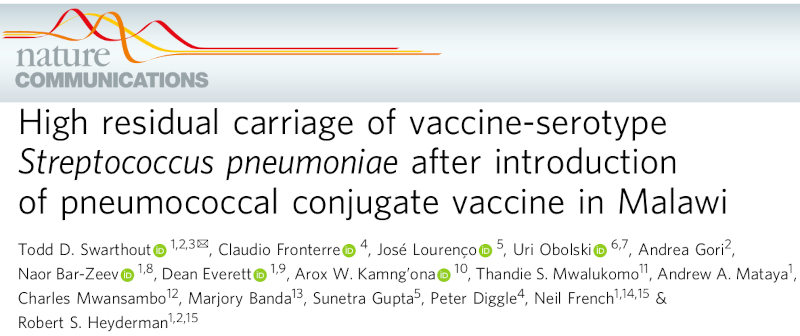
Abstract: There are concerns that pneumococcal conjugate vaccines (PCVs) in sub-Saharan Africa sub-optimally interrupt Streptococcus pneumoniae vaccine-serotype (VT) carriage and transmission. Here we assess PCV carriage using rolling, prospective nasopharyngeal carriage surveys between 2015 and 2018, 3.6–7.1 years after Malawi’s 2011 PCV13 intro- duction. Carriage decay rate is analysed using non-linear regression. Despite evidence of reduction in VT carriage over the study period, there is high persistent residual carriage. This includes among PCV-vaccinated children 3–5-year-old (16.1% relative reduction from 19.9% to 16.7%); PCV-unvaccinated children 6–8-year-old (40.5% reduction from 26.4% to 15.7%); HIV-infected adults 18-40-years-old on antiretroviral therapy (41.4% reduction from 15.2% to 8.9%). VT carriage prevalence half-life is similar among PCV-vaccinated and PCV-unvaccinated children (3.26 and 3.34 years, respectively). Compared with high- income settings, there is high residual VT carriage 3.6–7.1 years after PCV introduction. Rigorous evaluation of strategies to augment vaccine-induced control of carriage, including alternative schedules and catch-up campaigns, is required.
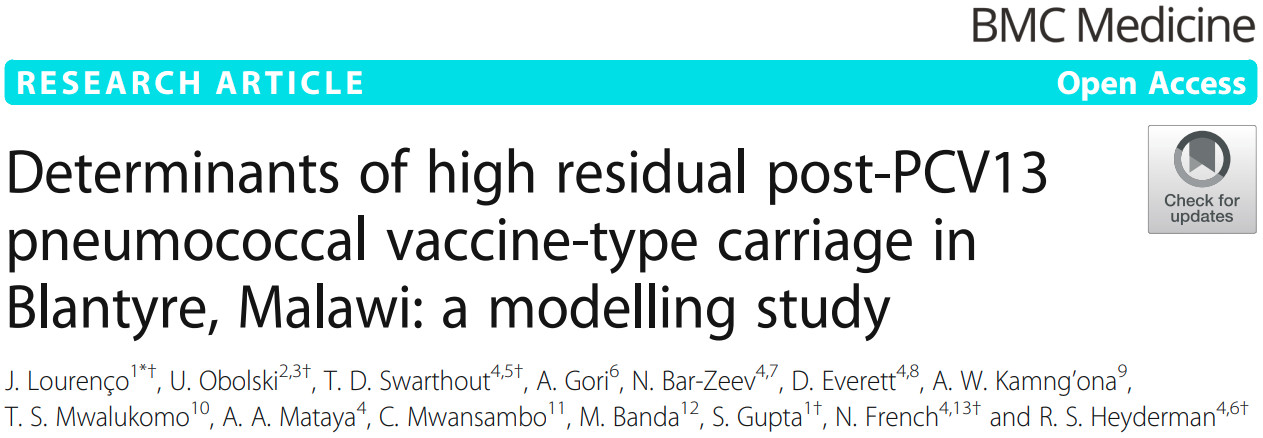
Abstract: In November 2011, Malawi introduced the 13-valent pneumococcal conjugate vaccine (PCV13) into the routine infant schedule. Four to 7 years after introduction (2015–2018), rolling prospective nasopharyngeal carriage surveys were performed in the city of Blantyre. Carriage of Streptococcus pneumoniae vaccine serotypes (VT) remained higher than reported in high-income countries, and impact was asymmetric across age groups. A dynamic transmission model was fit to survey data using a Bayesian Markov-chain Monte Carlo approach, to obtain insights into the determinants of post-PCV13 age-specific VT carriage. Accumulation of naturally acquired immunity with age and age-specific transmission potential were both key to reproducing the observed data. VT carriage reduction peaked sequentially over time, earlier in younger and later in older age groups. Estimated vaccine efficacy (protection against carriage) was 66.87% (95% CI 50.49–82.26%), similar to previous estimates. Ten-year projected vaccine impact (VT carriage reduction) among 0–9 years old was lower than observed in other settings, at 76.23% (CI 95% 68.02–81.96%), with sensitivity analyses demonstrating this to be mainly driven by a high local force of infection. There are both vaccine-related and host-related determinants of post-PCV13 pneumococcal VT transmission in Blantyre with vaccine impact determined by an age-specific, local force of infection. These findings are likely to be generalisable to other Sub-Saharan African countries in which PCV impact on carriage (and therefore herd protection) has been lower than desired, and have implications for the interpretation of post-PCV carriage studies and future vaccination programs.

Abstract: Viruses, such as dengue, Zika, yellow fever and chikungunya, depend on mosquitoes for transmission. Their epidemics typically present periodic patterns, linked to the underlying mosquito population dynamics, which are known to be driven by natural climate fluctuations. Understanding how climate dictates the timing and potential of viral transmission is essential for preparedness of public health systems and design of control strategies. While various alternative approaches have been proposed to estimate local transmission potential of such viruses, few open‐source, ready to use and freely available software tools exist. We developed the Mosquito‐borne Viral Suitability Estimator (MVSE) software package for the R programming environment. MVSE estimates the index P, a novel suitability index based on a climate‐driven mathematical expression for the basic reproductive number of mosquito‐borne viruses. By accounting for local humidity and temperature, as well as viral, vector and human priors, the index P can be estimated for specific host and viral species in different regions of the globe. We describe the background theory, empirical support and biological interpretation of the index P. Using real‐world examples spanning multiple epidemiological contexts, we further demonstrate MVSE's basic functionality, research and educational potentials.
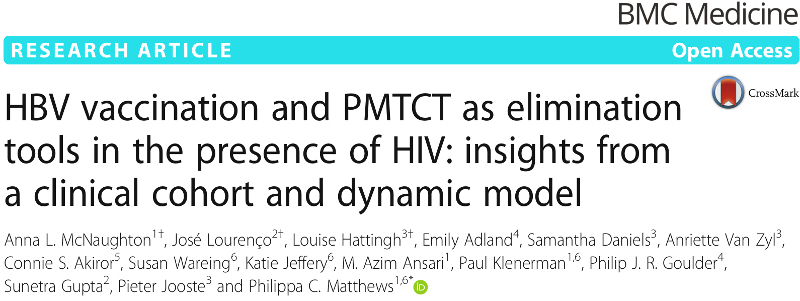
Abstract: Sustainable Development Goals set a challenge for the elimination of hepatitis B virus (HBV) infection as a public health concern by the year 2030. Deployment of a robust prophylactic vaccine and enhanced interventions for prevention of mother to child transmission (PMTCT) are cornerstones of elimination strategy. However, in light of the estimated global burden of 290 million cases, enhanced efforts are required to underpin optimisation of public health strategy. Robust analysis of population epidemiology is particularly crucial for populations in Africa made vulnerable by HIV co-infection, poverty, stigma and poor access to prevention, diagnosis and treatment. We here set out to evaluate the current and future role of HBV vaccination and PMTCT as tools for elimination. We first investigated the current impact of paediatric vaccination in a cohort of children with and without HIV infection in Kimberley, South Africa. Second, we used these data to inform a new parsimonious model to simulate the ongoing impact of preventive interventions. By applying these two approaches in parallel, we are able to determine both the current impact of interventions, and the future projected outcome of ongoing preventive strategies over time. Existing efforts have been successful in reducing paediatric prevalence of HBV infection in this setting to < 1%, demonstrating the success of the existing vaccine campaign. Our model predicts that, if consistently deployed, combination efforts of vaccination and PMTCT can significantly reduce population prevalence (HBsAg) by 2030, such that a major public health impact is possible even without achieving elimination. However, the prevalence of HBV e-antigen (HBeAg)-positive carriers will decline more slowly, representing a persistent population reservoir. We show that HIV co-infection significantly reduces titres of vaccine-mediated antibody, but has a relatively minor role in influencing the projected time to elimination. Our model can also be applied to other settings in order to predict impact and time to elimination based on specific interventions.
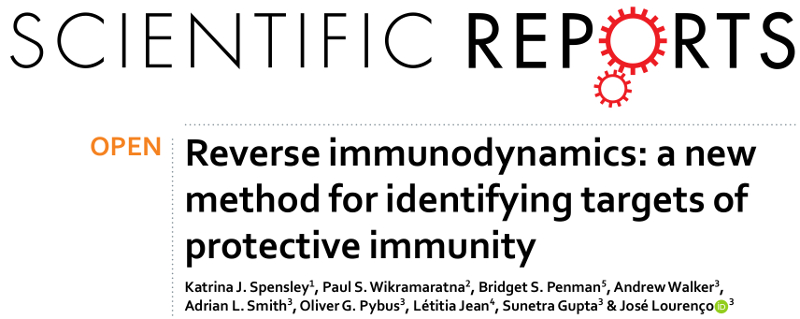
Abstract: Despite a dramatic increase in our ability to catalogue variation among pathogen genomes, we have made far fewer advances in using this information to identify targets of protective immunity. Epidemiological models predict that strong immune selection can cause antigenic variants to structure into genetically discordant sets of antigenic types (e.g. serotypes). A corollary of this theory is that targets of immunity may be identified by searching for non-overlapping associations of amino acids among co-circulating antigenic variants. We propose a novel population genetics methodology that combines such predictions with phylogenetic analyses to identify genetic loci (epitopes) under strong immune selection. We apply this concept to the AMA-1 protein of the malaria parasite Plasmodium falciparum and find evidence of epitopes among certain regions of low variability which could render them ideal vaccine candidates. The proposed method can be applied to a myriad of multi-strain pathogens for which vast amounts of genetic data has been collected in recent years.
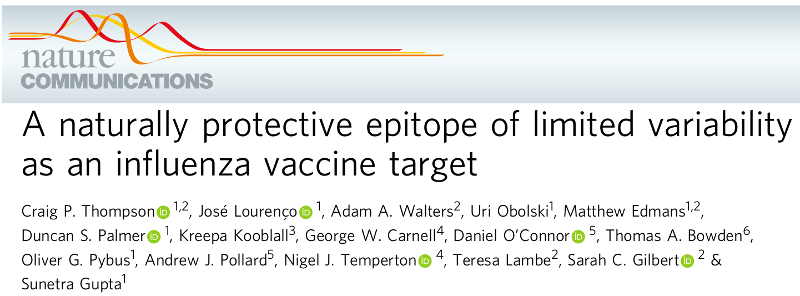
Abstract: Current antigenic targets for influenza vaccine development are either highly immunogenic epitopes of high variability or conserved epitopes of low immunogenicity. This requires continuous update of the variable epitopes in the vaccine formulation or boosting of immunity to invariant epitopes of low natural efficacy. Here we identify a highly immunogenic epitope of limited variability in the head domain of the H1 haemagglutinin protein. We show that a cohort of young children exhibit natural immunity to a set of historical influenza strains which they could not have previously encountered and that this is partially mediated through the epitope. Furthermore, vaccinating mice with these epitope conformations can induce immunity to human H1N1 influenza strains that have circulated since 1918. The identification of epitopes of limited variability offers a mechanism by which a universal influenza vaccine can be created; these vaccines would also have the potential to protect against newly emerging influenza strains.